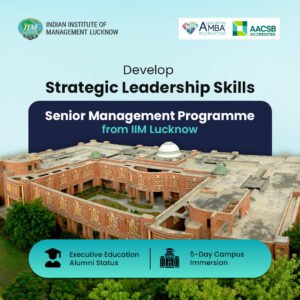It is said that today’s market is highly competitive. The phrase symbolises that the concept of monopoly is non-existent for almost all market products and services. Organisations utilise a series of well-defined processes and technology to manufacture a good quality product. They also utilise the best supply chain practices so that the products reach their customers on an earlier date.
There is fierce competition amongst different manufacturers and service providers having common client interfaces. The salient features of an organisation that enable it to produce cheaper and better products or render cost-effective quality services are referred to as competitive advantage.
Several reputed companies spend a fortune to leverage upon competitive advantage and increase operational efficiency over their rivals. They even sponsor the senior management course for their C-suite leaders and other key officials engaged in business and operation.
Competitive Advantage Strategies
To build a competitive advantage over rivals, an organisation must know its strengths and weaknesses. The general steps followed by companies are as follows:
Thorough market research
Market research energises an organisation to locate its target market for the products it plans to launch. Such efforts optimise the promotion or branding expenses and motivate target customers to purchase the products. Understanding customer needs is also an important aspect of this function.
Discover strength areas
A company always tries to leverage its strengths over its peers. Such parameters, which are often judged and compared by customers, may relate to availability, packaging, branding, delivery promptness, features, service excellence etc.
However, the internal strength areas to be focused upon are raw material sourcing, vendor selection, optimised supply chain management, and strong work culture and processes amongst others.
Competition study
It is always necessary to stay ahead of rivals. Thus, researching firms with similar business interests is a key factor to success.
Outsourcing
Hiring specialised firms to provide important business inputs is essential for a business advantage.
Financial monitoring
Organisations often use financial model systems to evaluate financial performance and identify growth centres. Operational competitive advantage is reflected in terms of increased profit through cost reduction. Effective working capital management and investment monitoring can help you gain an advantage over your competitors.
Operation review
Production and supply chain management are the most important pillars of operation management. Both processes are an inverse function of time. Thus, continuous research and reviews are required to have an edge over rivals.
Focus on service
Even the best product with a poor after-sales network is bound to fail. So, service excellence is a key factor to competitive advantage.
Innovation and research
An organisation progresses through the vision it envisages. Innovation and research must be an integral part of the work culture of a company to be successful.
Merger and acquisition
Sometimes these two processes help to eliminate competition and increase business coverage.
A solid senior management programme can help you learn how to get your company a competitive advantage over other brands or organisations.

Operation Management Pointers
Out of all the strategies discussed above, the ones involving operation management are, by far, the most important ones. The word operation denotes the entire gamut of business activities carried out by an organisation. It relates to those tasks which are carried out on the products manufactured or services catered by the organisation.
Operation excellence becomes the key differentiator for organisations in terms of profit maximisation and customer satisfaction. The main parameters based on which the key decisions are required to be taken are as follows:
Product
The chosen product should be able to address the client's expectations. Since customer requirements shift with time and other factors, the research wing of the organisation should take note of the same and should be ready to upgrade the products accordingly. A similar idea goes for service as well.
Quality
Besides the several features that a product may offer, it should be reliable and must have a “value for money” approach.
Process
The process of production should be minimalistic so that production takes the least time. The process should also ensure quality, as mentioned above.
Location
The location of the plant is very important since power and water availability should be abundant. Besides, the availability of raw materials and other vendor items should be smooth, as well.
Layout
Product layout is a main factor in producing the best product in optimum time. The layout of subsequent processing units must be closely stationed to save time and cost in production.
Inventory
A serious challenge in production management is having an optimum inventory. Having distribution centres at strategic points gives a cutting edge to an organisation.
Scheduling
Setting correct re-order levels of raw materials is considered proper scheduling.
Maintenance
The entire plant is run by automated machines. Thus, preventive maintenance plays a major role.
Human resources
All processes mentioned above can be performed effectively when managed and monitored by qualified and experienced manpower. Thus, human talent stands tall as a backbone for gaining competitive advantage.
If you wish to learn more about operations management, a senior management certification programme can help you out.
Operation Excellence Strategies
An operation staff must keep in mind the following strategies to achieve operation excellence:
Cost leadership
In a general consumeristic market, cost leadership is the key to the sustainability and profitability of an organisation. Reduction of cost with better quality standards for sale price competitiveness needs to be followed. However, this can be achieved through a huge market footprint. Effective financial management is extremely important for achieving operational excellence.
Differentiation
Some unique products are sold based on the value proposition to clients and cannot be imitated by other manufacturers. These special products create a niche market for the organisation through innovation, trust and absolute quality standards.
Focus
This approach takes both cost and differentiation into consideration. The organisation identify or creates a market and then develops products as per the requirements of that chosen market.
Conclusion
Only the fittest will survive and sustain in the business world. Targeting markets, product or service value proposition and competition research are the cornerstones to effective operation goals and provide competitive advantage. Leaders should be trained to streamline the team towards the common goals to achieve brand value, profit and client delight.
The Senior Management Programme by Imarticus will enable prospective candidates to have huge growth right at the start of their careers. The duration of this senior management course is 6 months.
Visit the official website of Imarticus for more details.


